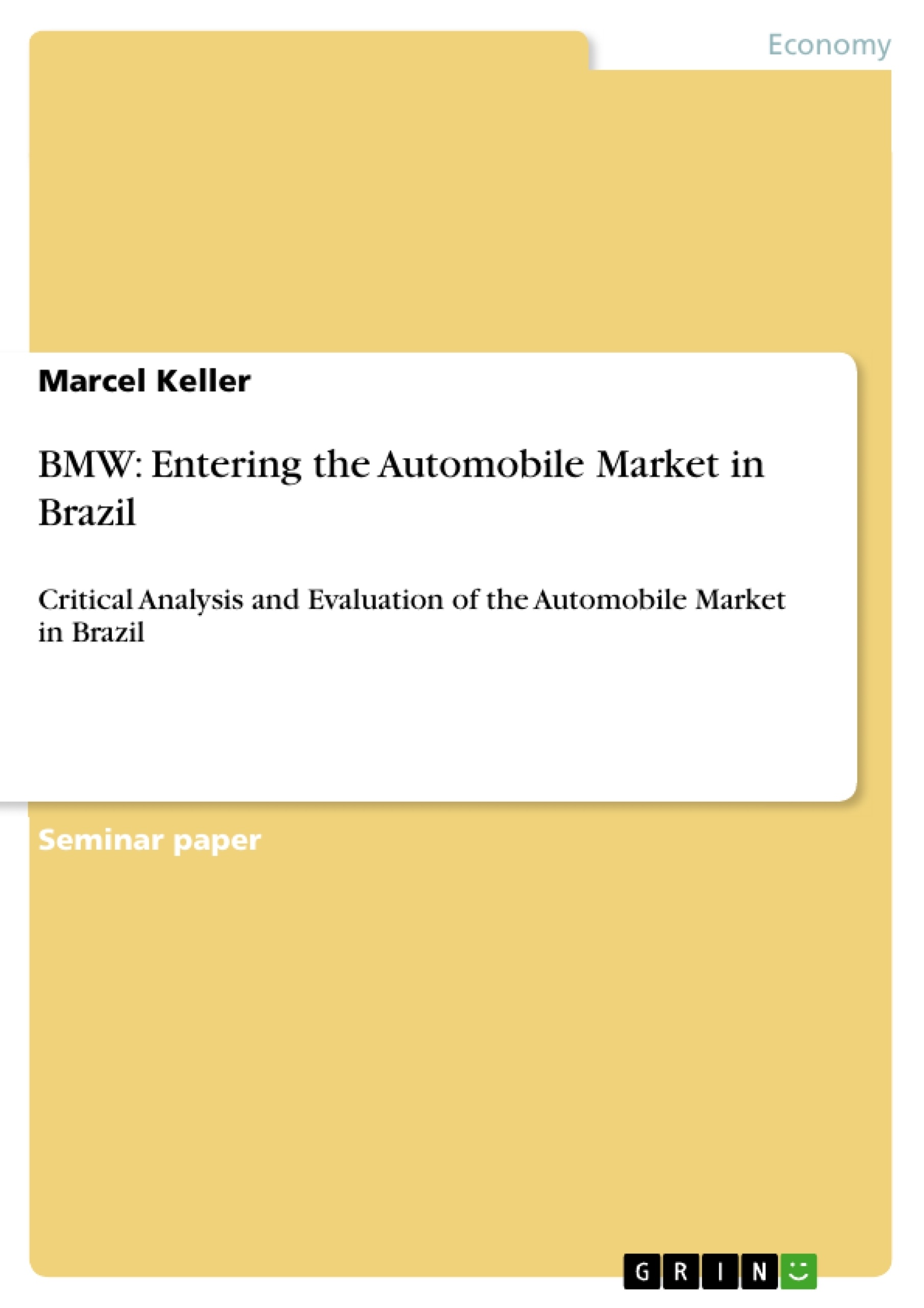The ongoing globalisation and the interrelated trade of goods and services are an integral part of today’s business. In particular, the automobile industry plays an important role within the global environment, because of their strong linkages within the global economy.
The increased international commitment of car manufacturers is driven by, on the one hand issues of limited opportunities in their respective home markets and, on the other hand, superior opportunities in emerging markets such as China or India. Therefore, motives for entering new markets can be either proactive, for example, expand market share, lower costs or the availability of resources or they can be reactive, for example, to remain competitive. For instance, German car manufacturers are faced by a highly competitive home market, not only within the mass market, but in the premium market as well. BMW, for instance, has been proactive by taking the opportunity to enter new markets such as China where it has produced cars since 2003. Furthermore, BMW assemblies its cars with a reassembly production process in India, Thailand, Malaysia and Indonesia.
However, these are just a few emerging economies where the company seeks its opportunities. Emerging economies such as Brazil offer auspicious potential for foreign investors as well. Brazil is the eighth largest economy by Gross Domestic Product (GDP), the fifth by population and the fourth largest car market in the world. While other companies just consider investments in emerging markets, BMW already benefits by exporting its cars to Brazil. Nevertheless, to take full advantage of the market the company contemplates entering Brazil´s car market by foreign direct investment. Consequently, BMW has to investigate the Brazilian market very thoughtfully.
The aim of this report is to critically analyse and evaluate the automobile industry as well as the business environment in Brazil with reference to BMW. Furthermore, the report identifies recommendations to develop a long-term market entry strategy in order to act successfully in the market.
Inhaltsverzeichnis (Table of Contents)
- Introduction
- BMW within the Global Automobile Industry
- Automobile Industry at a Glance
- Competitors, Suppliers and Potential Entrants
- Buyers and the Risk of Substitutes
- New Opportunities in Emerging Markets with Focus on Brazil
- Business Environment in Brazil
- Political and Legal Factors
- Economic and Infrastructural Factors
- Sociocultural and Technological Factors
- Strategic Reasons for Expanding to Brazil
- Market Entry Strategy
- Current Market Strategy and Selection of Preferred Entry Mode
- Identifying Strategic Options for Preferred Entry Mode
- Recommendations
- Conclusion
Zielsetzung und Themenschwerpunkte (Objectives and Key Themes)
This report aims to critically analyze and evaluate the global automobile industry as well as the business environment in Brazil with particular focus on BMW. The report identifies recommendations for developing a long-term market entry strategy in order to ensure the company's success in the Brazilian market.
- The global automobile industry and its characteristics
- Analysis of the Brazilian business environment
- Evaluation of strategic entry options for BMW
- Recommendations for a long-term market entry strategy
- Opportunities in emerging markets, particularly Brazil
Zusammenfassung der Kapitel (Chapter Summaries)
The first chapter introduces the report's scope, highlighting the significance of the global automobile industry and its relevance to BMW's international expansion. The chapter emphasizes the company's proactive approach to entering emerging markets like Brazil, driven by limited growth opportunities in its traditional home markets.
Chapter 2 delves into the global automobile industry, providing an overview of its structure, key players, and competitive dynamics. It utilizes Porter's Five Forces framework to analyze the industry's competitive landscape and identifies opportunities for growth, particularly in emerging markets such as Brazil.
Chapter 3 focuses on the specific business environment in Brazil, examining the political, economic, social, and technological factors influencing the country's attractiveness as a market for foreign investors. It highlights the growth potential of the Brazilian automotive sector, making it a compelling target for companies like BMW.
Chapter 4 focuses on the market entry strategy for BMW in Brazil. It explores different entry modes and recommends a strategic approach based on the company's current operations, competitive advantage, and long-term goals in the Brazilian market.
Schlüsselwörter (Keywords)
The report focuses on the following key areas: global automobile industry, emerging markets, market entry strategy, Brazil, BMW, Porter's Five Forces, business environment, strategic options, competitive advantage, international expansion, foreign direct investment.
- Quote paper
- M.Sc., B.A., B.Sc. Marcel Keller (Author), 2012, BMW: Entering the Automobile Market in Brazil, Munich, GRIN Verlag, https://www.grin.com/document/269268




